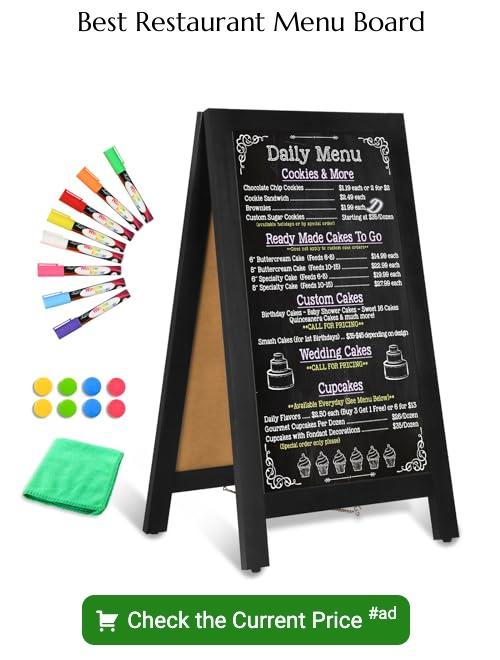Last updated on
Creating a captivating restaurant specials board matters, because it can significantly enhance your customer’s dining experience, spark their curiosity, and ultimately lead to higher sales.
I’ve designed unique illustrations for these ideas. I hope you get inspired!
Diving straight into the vibrant world of restaurant specials boards—often the first eye-catching element for customers. Unquestionably, you can spot an abundance of board ideas floating around the internet. While you will find resources attached for those at the end of this article, the real aim here is to stir the creative soup and serve up a fresh batch of unique concepts.
Imagine approaches that are hitherto untapped, perspectives that tilt the canvas into a new light. Embark on this exciting culinary wave and prepare to be inspired by a unique list of restaurant specials board ideas that promises more than just the ordinary.
Utilizing Eco-Friendly Elements

Incorporating green components into your specials board makes a strong visual impact while also showing your commitment to sustainability. Consider using reclaimed wood or chalkboards as an eco-conscious choice, reducing waste created by paper menus.
To further demonstrate your dedication, opt for plant-based or low-VOC chalkboard paint where possible.
Highlight dishes that use locally sourced, organic, or sustainably harvested ingredients, connecting the eco-friendly theme to your culinary offerings. For a creative touch, design food illustrations using natural materials like charcoal or organic paints. It’s an effective method to underscore your ethos and create an engaging visual experience for your guests.
Take it a step further by displaying the waste-reduction practices your restaurant employs; whether it’s composting, recycling, or minimal packaging, patrons usually appreciate knowing they’re dining at an environmentally conscious establishment. Just a few subtle nods to your green practices can have a significant effect on your patrons’ perceptions.
Remember, aligning your specials board with your eco-friendly initiatives doesn’t have to feel forced. With thoughtful planning and creativity, you can create a visually stunning board that showcases your unique dishes whilst affirming your commitment to the environment.
Emphasizing Vegetarian and Vegan Options
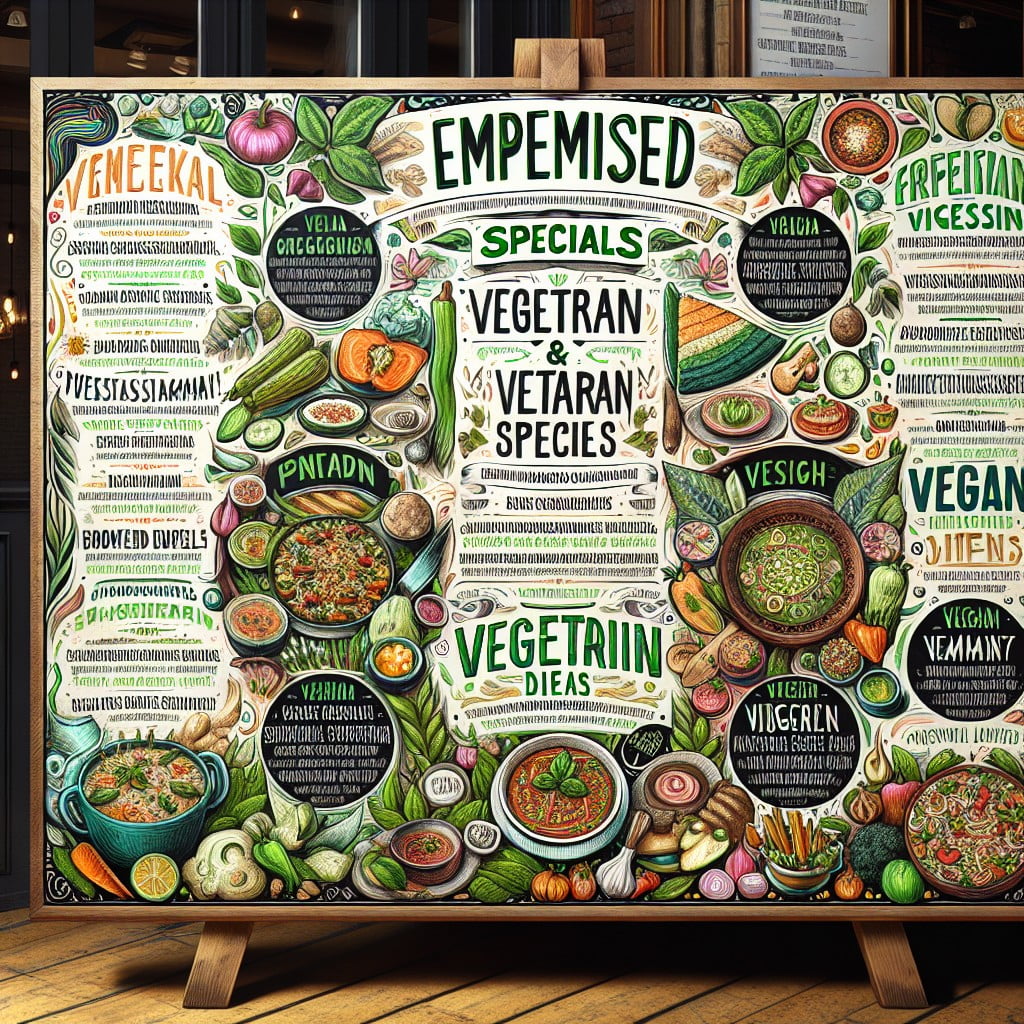
Offering a clearly labeled section for plant-based diners is an advantageous move, since it caters to the increasing number of people who identify as vegetarians or vegans. Including options that use high-quality, sustainable, vegan, and vegetarian ingredients allow these customers to appreciate your establishment’s inclusivity.
1. Use symbols or icons: Clearly define vegan or vegetarian dishes with universal symbols to allow for easy identification.
2. Describe ingredients: Lean into the details by giving short, captivating descriptions about the sources, benefits, or tastes of the ingredients used in these special dishes.
3. Present variety: Showcase the diversity of vegetarian and vegan cuisine by adopting dishes from different global traditions.
4. Indicate substitution options: Allow flexibility by showing how certain dishes can be made vegan or vegetarian upon request.
Remember, by emphasizing these options, you’re not just catering to a subset of customers but also attracting health-conscious foodies, who might not necessarily be vegetarians or vegans but enjoy trying plant-based dishes.
Showcasing Customer Reviews
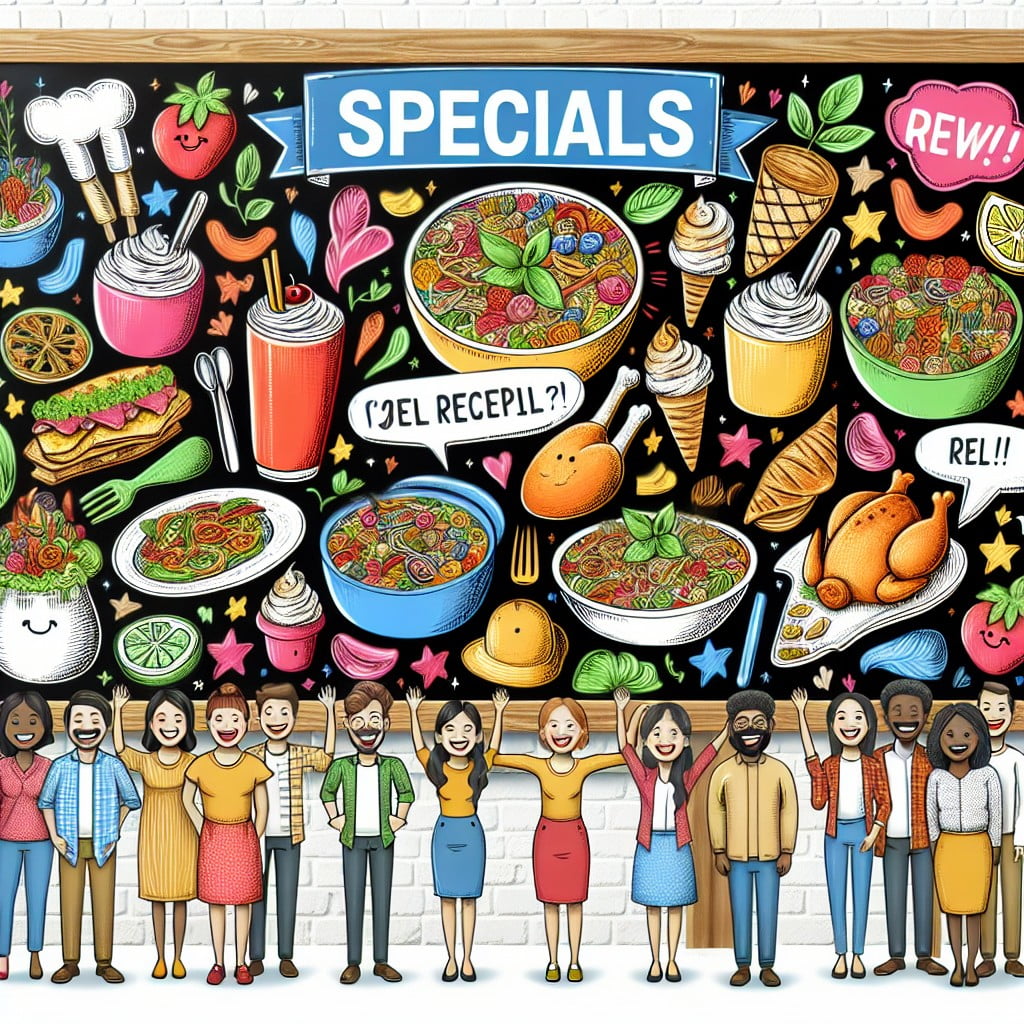
A compelling way to generate interest is by spotlighting positive feedback from customers. People trust peer reviews and they can induce curiosity about specific dishes. Incorporating these comments on the specials board can influence decisions, especially among first-time visitors.
1. Exhibit Credibility: Use genuine comments to emphasize the reliability of your establishment and offerings.
2. Making Use of Social Media: Consider extracting reviews from platforms like Yelp or TripAdvisor where your restaurant is listed.
3. Highlight Popular Dishes: Direct feedback about specific dishes will encourage other customers to try them.
4. Visual Engagement: Incorporate star ratings, expressive emojis, or creatively display quotes to grab attention.
Recall, that the goal is not to simply fill the space but to carefully select reviews that reinforce the unique attributes of your eatery, whilst giving prospective customers insight into what to anticipate.
Feature Local Farm Suppliers
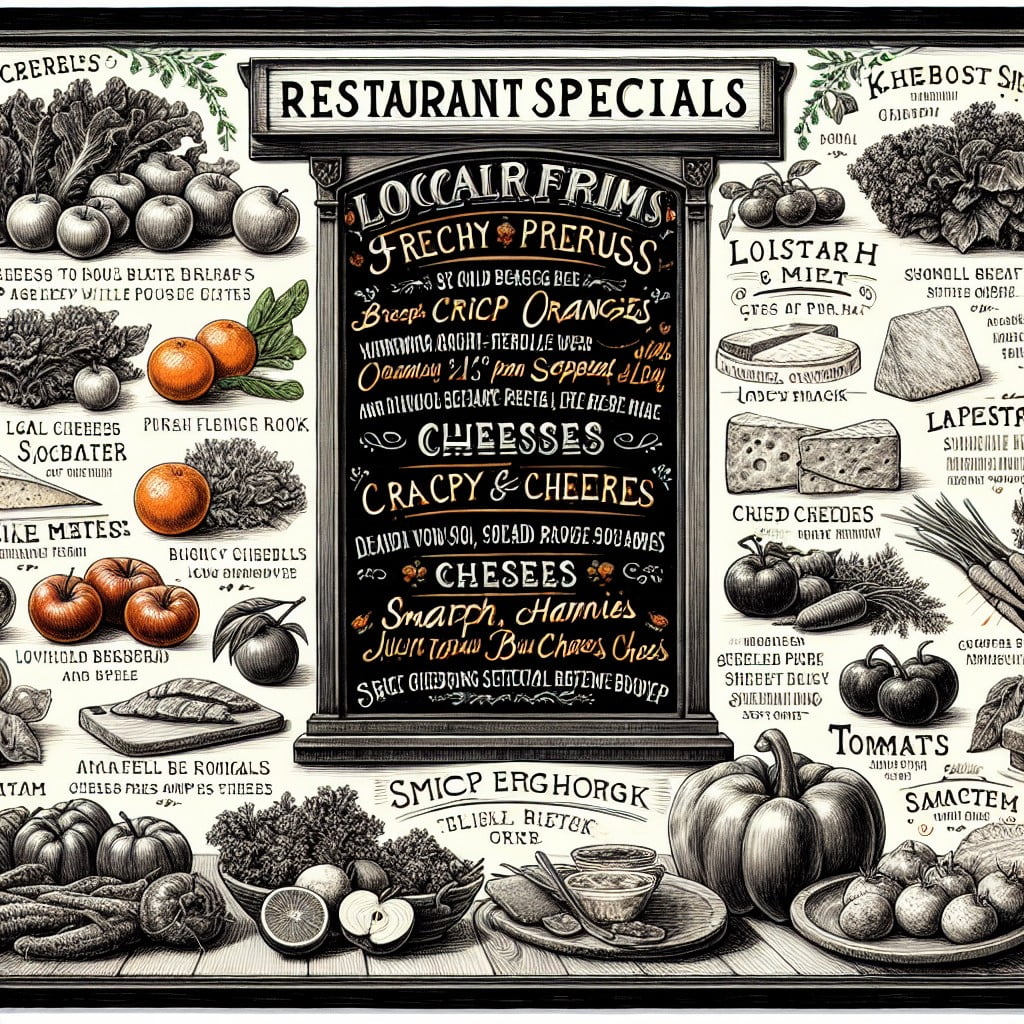
Investing in relationships with local farmers benefits not only the ‘farm to plate’ philosophy but also serves as a unique selling point in a sea of competition.
1. Highlight Provenance: Restaurants can add a personal touch by sharing the origins of the produce, freshly plucked from local farms, promoting an eco-friendly and sustainable ethos.
2. Spotlight Farmer Bios: An excellent way to gain customer trust and interest is by presenting short biographies of the local farmers and suppliers. This could include photos, a brief overview of their farming practices, and a quote.
3. Dynamic Menus: Changing the menu based on the season and availability of ingredients can be an engaging experience for customers. Freshness is guaranteed as produce travels less distance and it gives an opportunity to introduce new dishes to the menu.
4. Promote Specialties: Local suppliers may offer unique food items that are not available at other places. Use the specials board to show these off. These could be heirloom vegetables, rare breed meats or artisan cheeses.
Remember, transparency can form a connecting bridge between consumer, farm, and restaurant, and your specials board is the perfect canvas to showcase this relationship.
Highlighting Dishes With International Spices
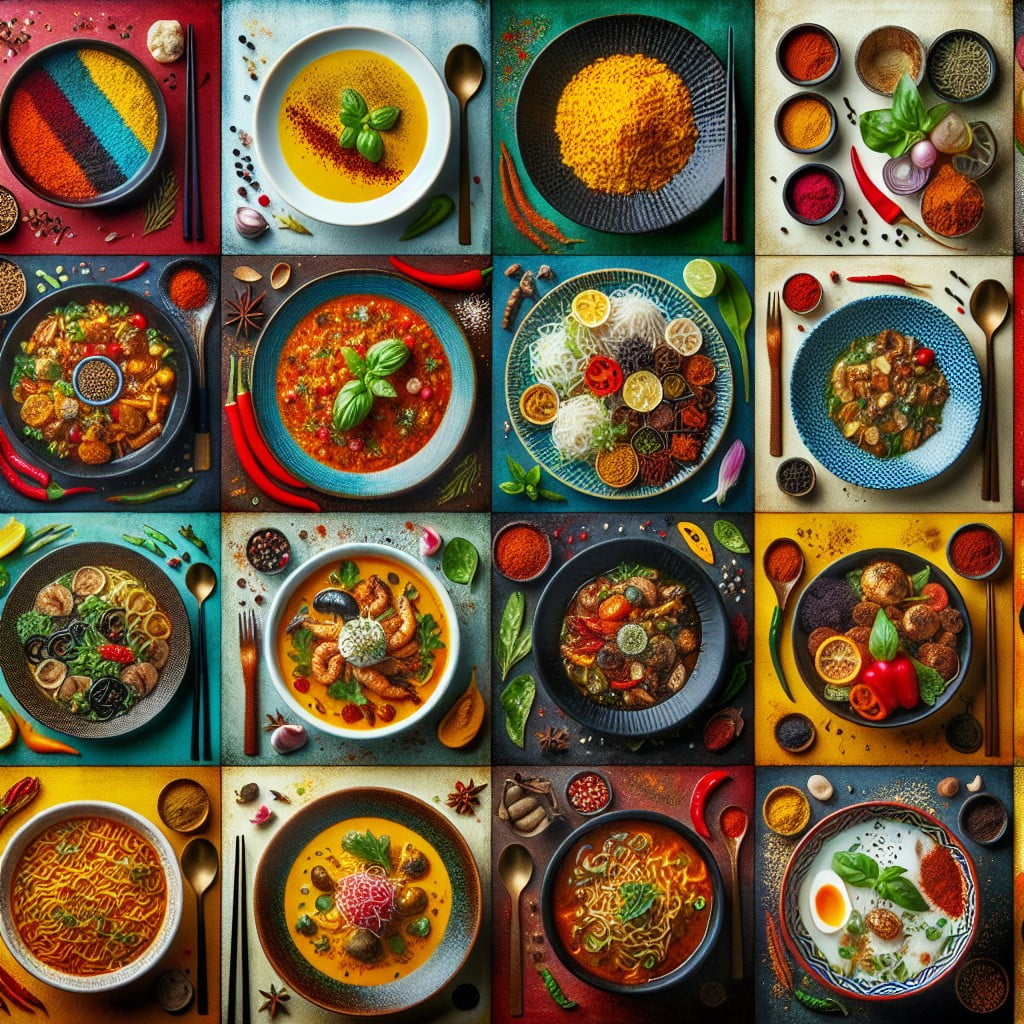
Interesting flavors and spices from around the world can elevate a simple dish to something extraordinary. First, identify the spices that are unique to particular regions. For instance, garam masala for an Indian-inspired dish, za’atar for Middle Eastern influence, or even everything bagel seasoning for an American twist.
When incorporating these spices into your specials, remember to stay authentic to the flavor profiles. You wouldn’t want to merge too many flavors that might clash and confuse the palate. Always make sure to use high-quality spices, and when possible, grind your spices to ensure fresher and more potent flavors.
To effectively highlight these dishes on the specials board, consider using a brief enticing description. Include the origin of the spice and its unique flavor profile. This will pique your customers’ curiosity and make the dish even more appetizing.
Finally, consider colorful displays to represent the dishes’ vibrant flavors. This visual intrigue can be an eye-catching way to entice customers to try something new.
Dietary Requirement Specials Board
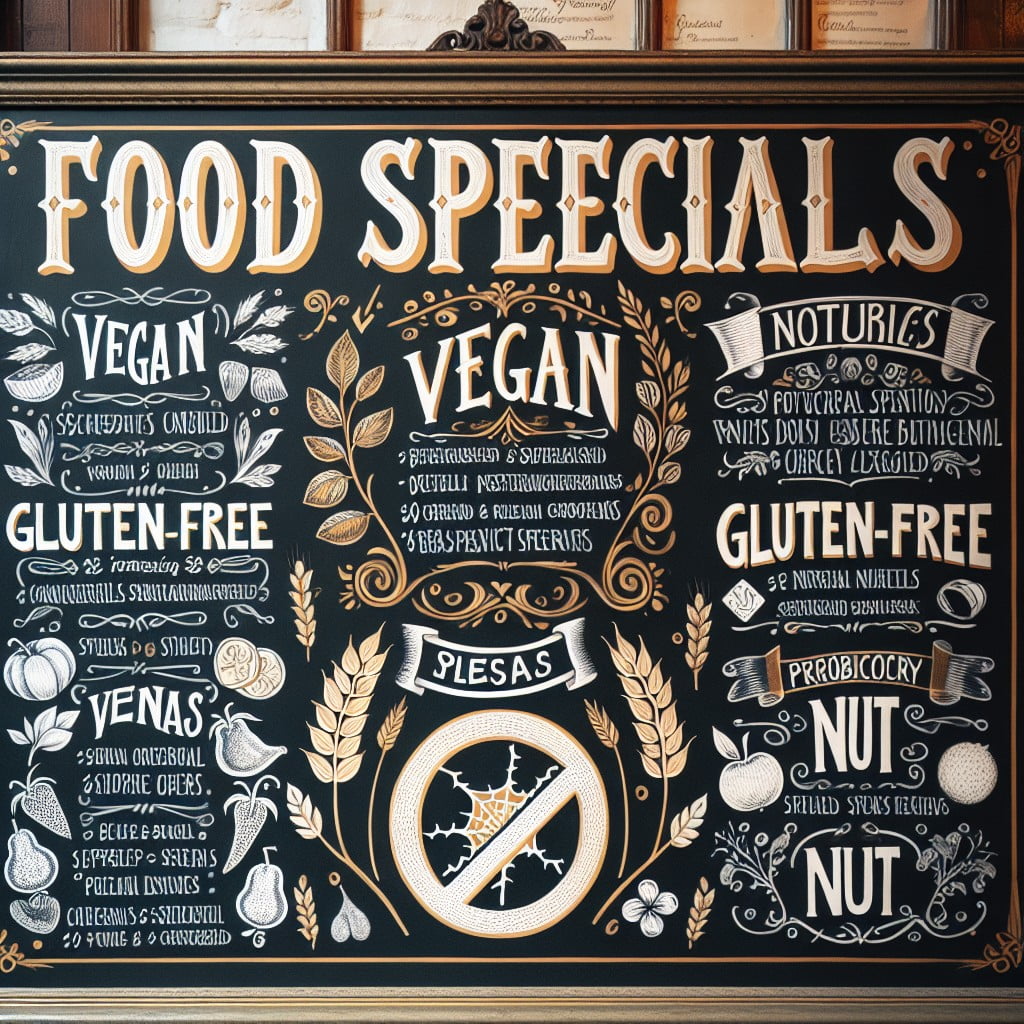
Considering diversity in dietary requirements not only makes a restaurant more inclusive, but also broadens its customer appeal. Here are ways to make your specials board responsive to a range of dietary preferences and restrictions:
1. Identify dishes that cater to gluten-free, dairy-free, nut-free, sugar-free, and other dietary preferences directly on the board. Clear labelling saves your guests the trouble of checking with the server.
2. Showcase your vegetarian and vegan delights, making them attractive even to non-vegetarians.
3. Specify low-carb or keto-friendly options for those following specific diet plans.
4. Include delectable dishes for guests with allergies. Your awareness of their needs often translates into their loyalty.
5. Consider featuring ‘clean eating’ dishes, satisfying patrons interested in unprocessed, whole foods and ingredients.
Remember, a thoughtful menu board communicates that everyone is welcome at your establishment, regardless of their dietary restrictions or preferences.
Kids Menu Specials Board

A dedicated board for children’s offerings can be an appealing addition. Here are points to consider for this:
1. Simplicity is key: Children generally prefer familiar foods, so keep dishes recognizable and straightforward.
2. Presentation matters: Make menu items sound fun and inviting – perhaps ‘Treasure Chest Fish Fillets’ instead of plain fish sticks.
3. Include food emblems: Utilize harmless and inviting symbols like little superheroes or princesses to resonate with the young ones’ imaginations.
4. Healthy options: Incorporate nutritious dishes subtly. Perhaps, grilled chicken strips instead of fried or fruits as side options.
5. Portion sizes: Specify that meals are child-size to assure parents the servings are appropriate.
6. Edible colors: Children are attracted to white, pink, red, and yellow meals. You might want use natural colorants like beet or spinach juice.
7. Parental needs: Make it all allergy-conscious. Dairy-free, gluten-free, and nut-free options are a relief for parents.
Remember, a simple, brightly colored, and fun-inspired children’s specials board can elevate the dining experience for the whole family.
Pairing Dishes With Wines or Beers
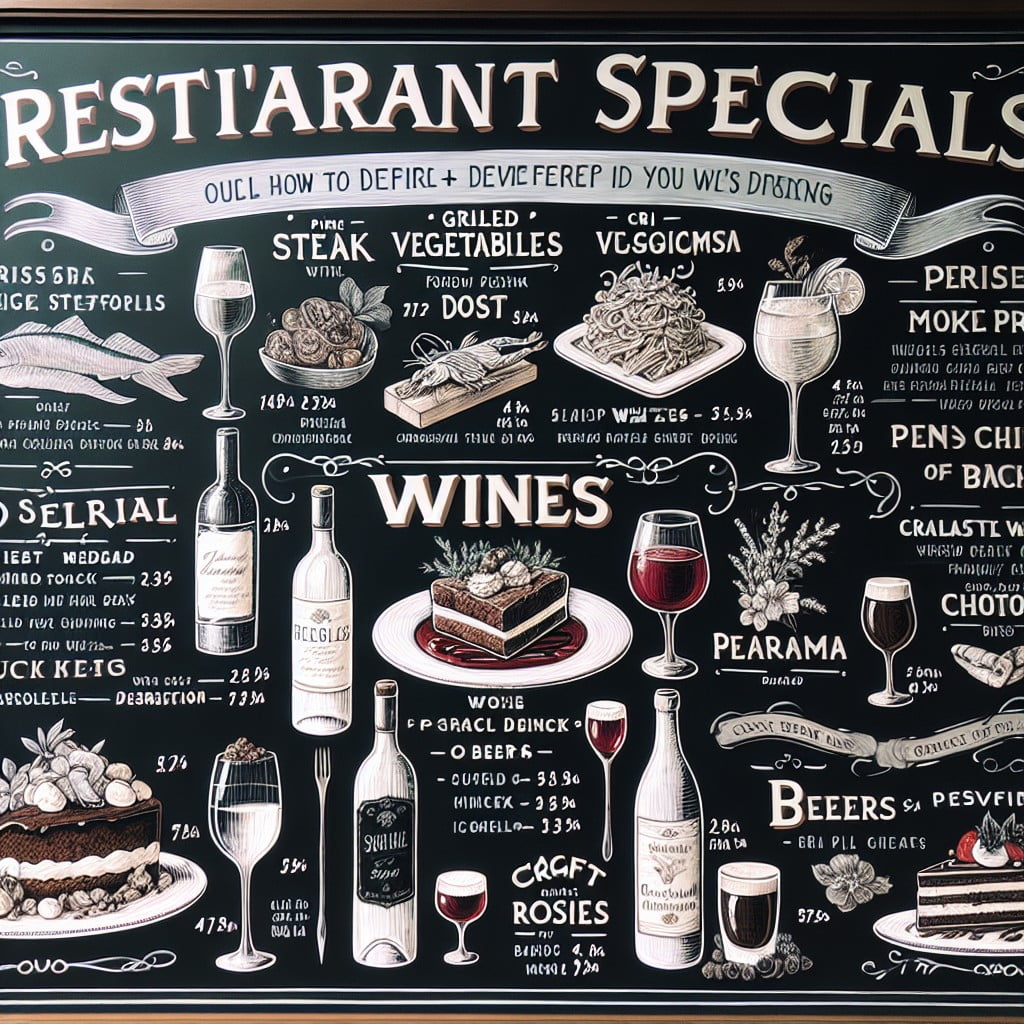
A well-executed pairing can truly elevate the dining experience. Here’s how:
1. Complement or Contrasting Flavours: Opt for a wine or beer that either complements the dish’s flavours or contrasts them. A hearty steak, for example, pairs well with a robust red wine while spicy food typically complements lighter, fruitier beers.
2. Remember the Rule of Balance: The weight of both your dish and beverage should be in balance. You wouldn’t want a light salad to overwhelm a delicate champagne, or a rich stout to overpower tender grilled fish.
3. Seasonal Considerations: Seasonal beers and wines can inspire seasonal dishes. A spring rosé might inspire a fresh seafood dish, or a winter stout could accompany a decadent chocolate dessert.
4. Diners’ Preferences: Bear in mind individual preferences and dietary restrictions. Offer non-alcoholic pairings for those who don’t consume alcohol.
5. Staff Knowledge: Ensure the staff is well-informed to suggest adequate pairings. This can greatly enhance the customer dining experience and foster a climate of trust.
Expressed effectively, this concept encourages exploration and adds value to your specials board.
Explaining the Origins or History of Dishes
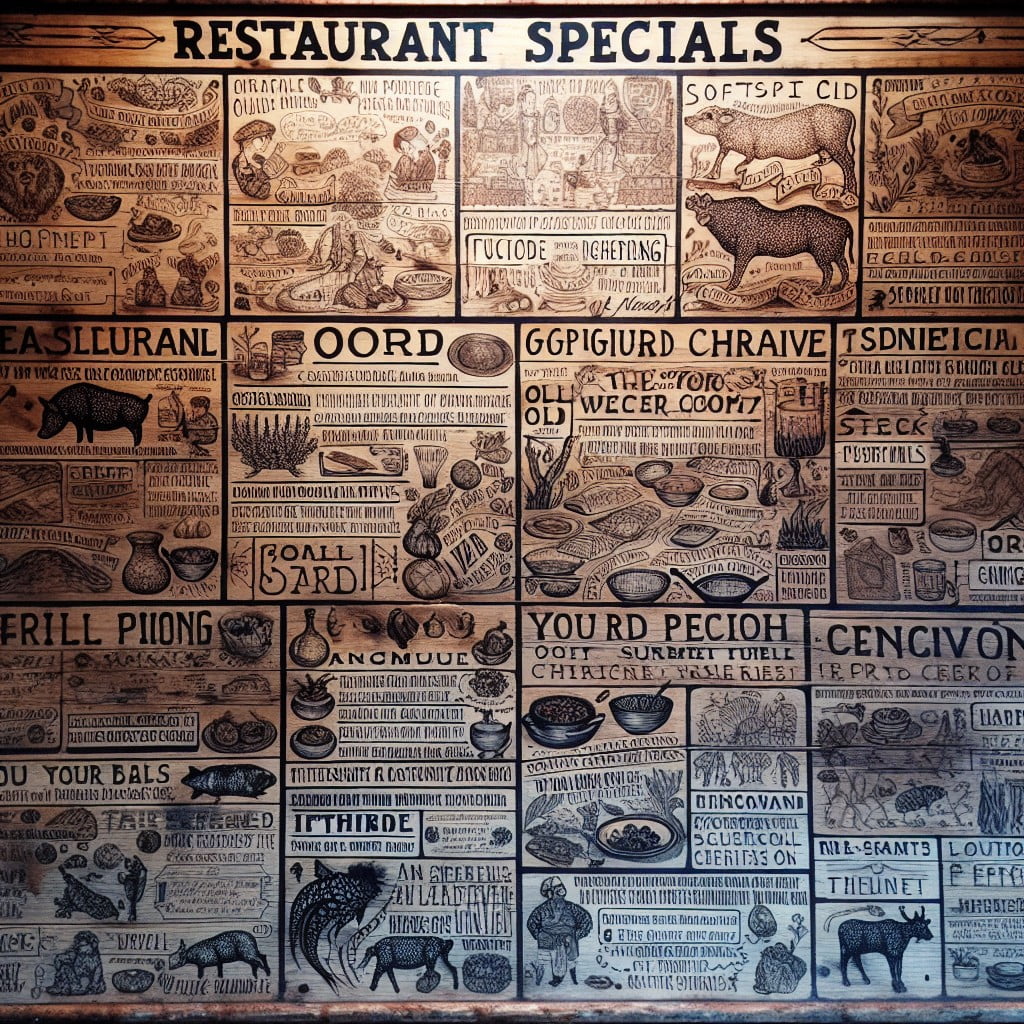
Delving into the background of signature meals offers a captivating way to engage diners and may influence their ordering choice. The narratives surrounding origins of menu item potentially increase its allure, be it a hometown homage, a family recipe passed down generations, or a dish inspired by a chef’s travels.
1. Appeal to Emotions: Sharing stories of meals connected to personal experiences stirs the emotional side of choosing what to eat, making it more than just a decision based on taste or preference.
2. Highlight Unique Ingredients: If a dish contains special ingredients, sourced internationally or locally, this provides an opportunity to underline its distinctive character.
3. Cultural Relevance: Share the cultural origins of the dishes, if applicable. This brings insight into global culinary traditions and could satisfy the curiosity of adventurous diners.
4. Inspiring Appreciation: Understanding the history and the development process behind dishes helps cultivate a deeper appreciation for the food and the culinary skills behind it.
5. Promotes Conversation: Such narrations encourage dining table talks and fascinating anecdotes about the dishes, promoting a convivial ambiance.
Remember, the objective here isn’t to write an entire history book, but to provide intriguing glimpses into the creation and evolution of your eatery’s specialties.
Meal of the Day or Week Highlight
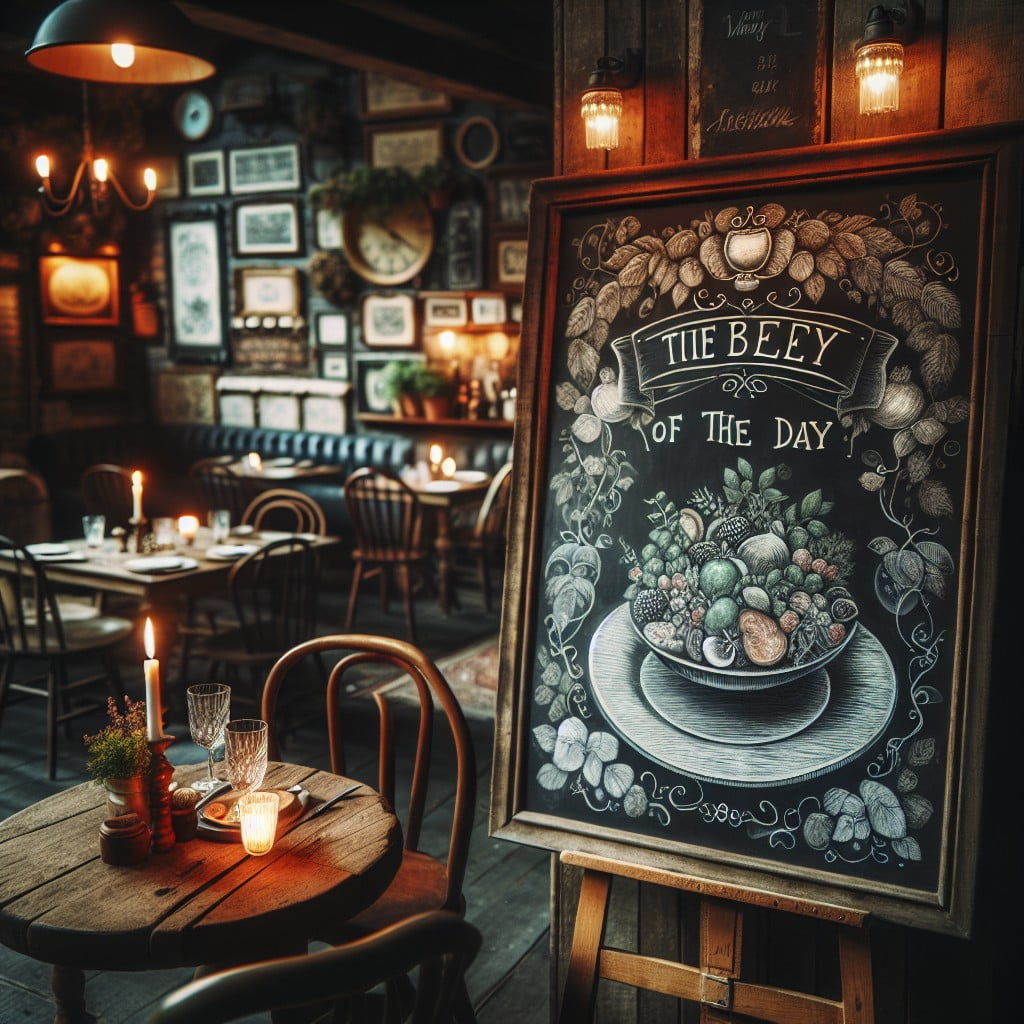
With this method, the focus falls on a particular dish—maybe the chef’s latest creation or a time-tested crowd favorite—that is promoted for the day or week. A well-chosen selection can get customers excited about your menu and encourage frequent visits to try the latest feature.
1. Innovation and Variety: This allows the chef the creative freedom to experiment with various dishes, introducing customers to a variety of flavors and cuisines that they might not have tried otherwise.
2. Customer Engagement: By highlighting the meal, it can generate anticipation and discussion among clients, keeping them engaged and looking forward to your restaurant’s offerings.
3. Inventory Management: This strategy can also help the restaurant manage its inventory more effectively. If certain ingredients are excess in stock, create a special dish around them.
4. Upselling Opportunities: It presents an opportunity for upselling, as customers may be more likely to go for a promoted dish that comes fully cooked, rather than a regular menu item.
5. Niche Appeal: A regular rotation of unique dishes can attract a more adventurous set of diners, opening up a potential new customer base.
Promoting Limited-Time Only Dishes
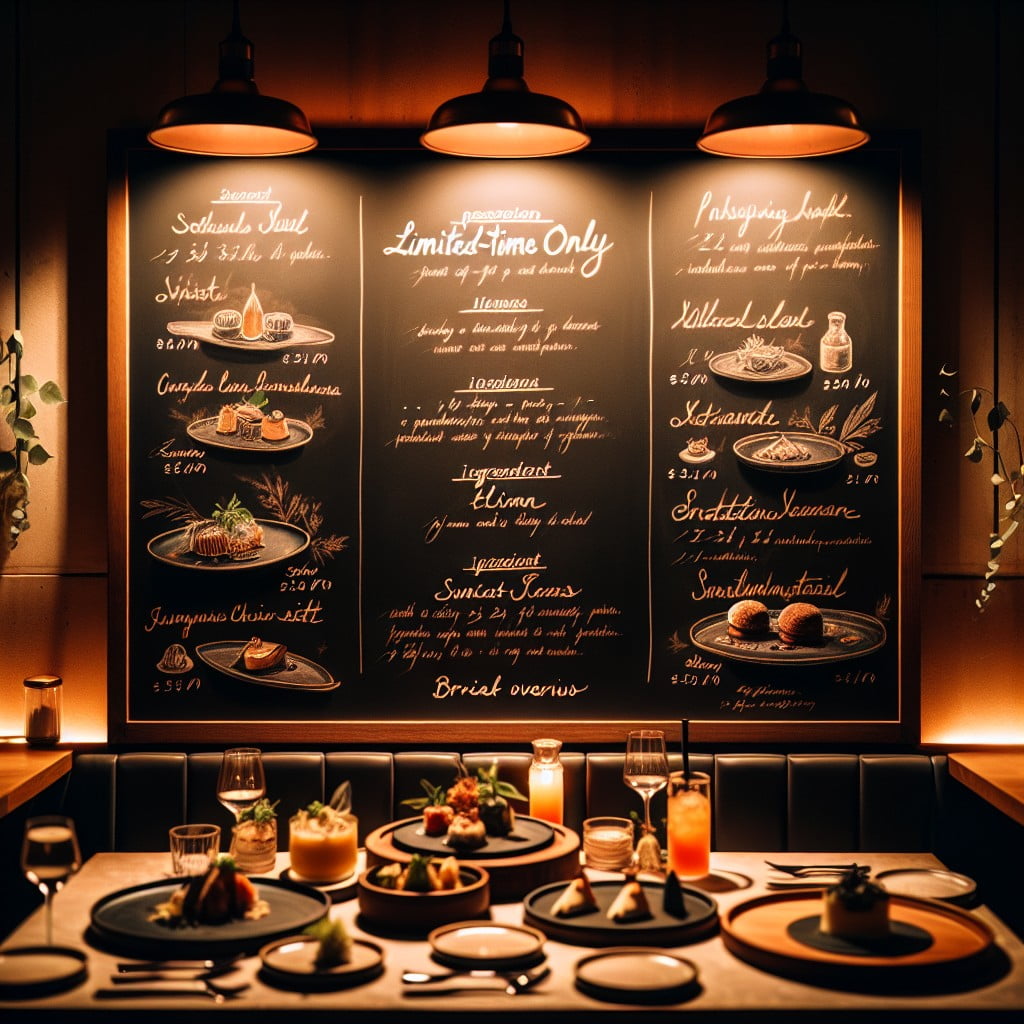
Creating a sense of urgency can boost customer interest and sales of particular dishes. Limited-time offers are more than marketing tools—they can act as culinary experiments allowing formative feedback on prospective additions to your permanent menu.
Consider options that revolve around seasonal ingredients, and don’t shy away from the unconventional. Unique ingredients not only draw attention, but also impart exclusivity to the dish. Your board should communicate this effectively—indicate the duration of the offering and the exclusive features of the dish.
Finally, ensure staff is well-acquainted with the dish to accurately inform inquiring customers, adding a personal touch to this tantalizing promotion.
Always remember, the allure of a fleeting delicacy can work wonders in tantalizing taste buds and boosting your restaurant’s appeal.
Showcasing Chef’s Signature Dishes
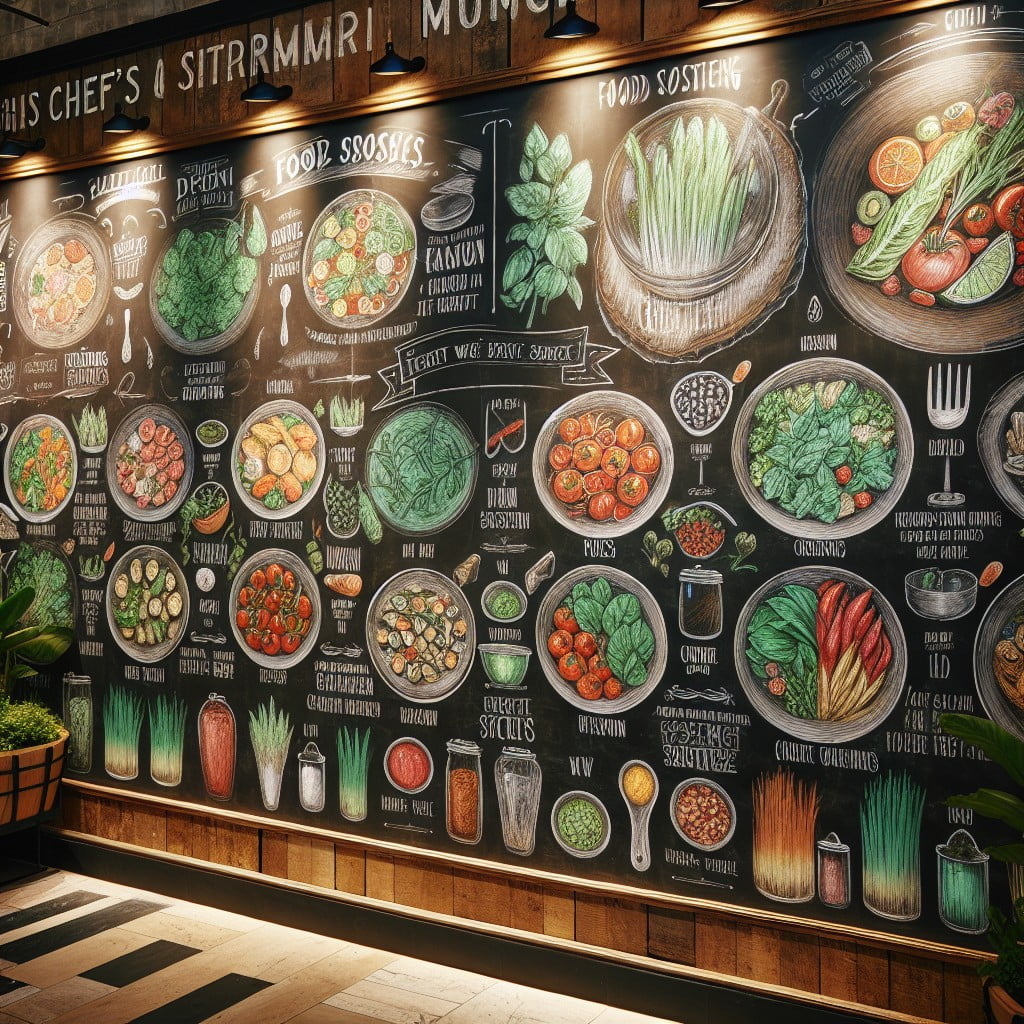
Highlighting the chef’s creativity and passion, a signature dishes board introduces diners to special meals known for unique flavors and presentations. This not only adds a touch of exclusivity to the menu, but it also fosters a personal connection between the kitchen and the patrons.
Here are a few conceptual points to make such a board truly shine:
- Selection: Include all-time favorites and innovative concoctions. Choose between 5 and 7 dishes to keep the board focused and enticing.
- Description: Use vivid language to elucidate the ingredients and cooking method. This attracts interest and creates anticipation.
- Visuals: Incorporating illustrations or photos of the dishes tantalizes the imagination, and triggers salivation.
- Staff Knowledge: Train servers about these dishes so they are prepared to answer queries and recommend them to uncertain customers.
- Promotion: Use your restaurant’s social media pages to further showcase these dishes and attract new customers to try them out.
Stay mindful of your audience, and you’ll soon see how a signature dishes board can turn new customers into loyal patrons.
Board With Dish Preparation Times
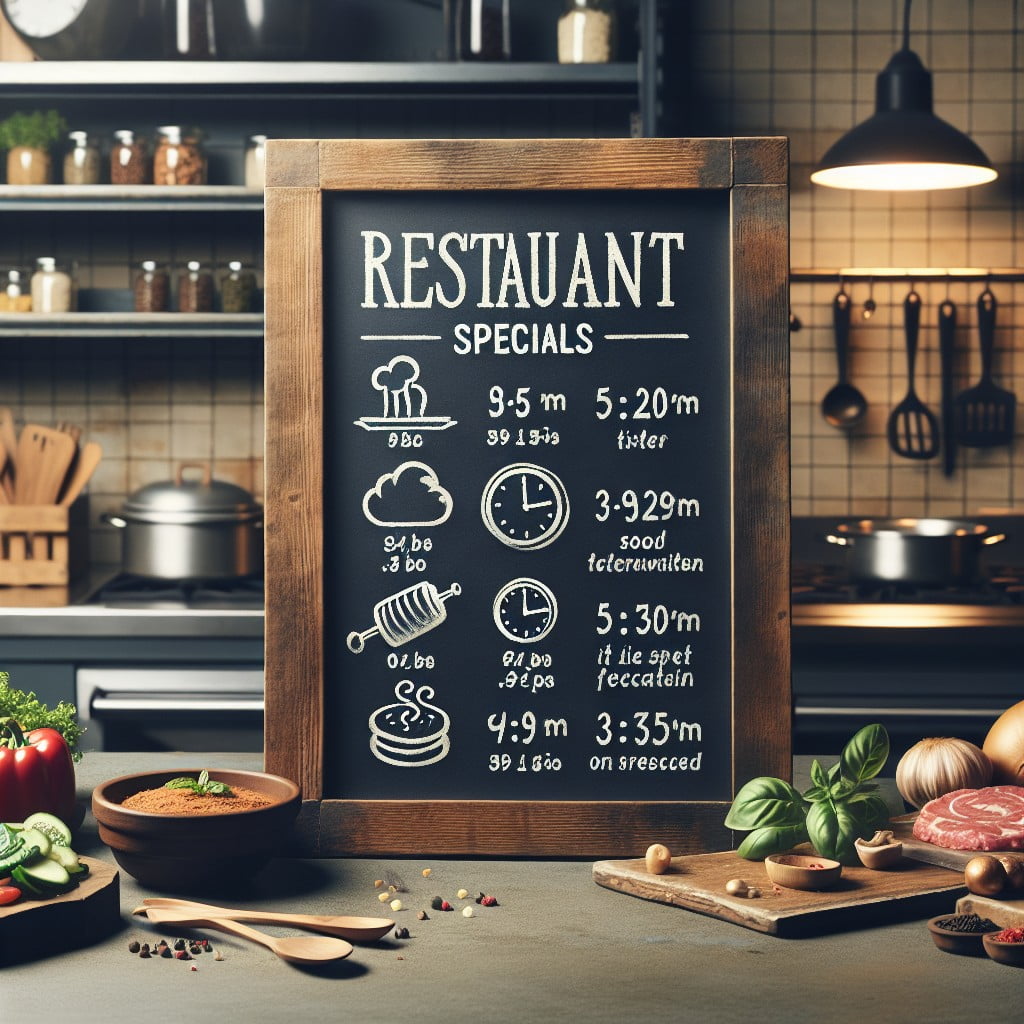
A thoughtful addition, revealing preparation times offers guests a glimpse into what goes behind their favorite meals. It serves as an ideal guide for quick-lunch seekers or those with a bit more leisure time. Say, for instance, a wood-fired pizza takes about 15 minutes, while a slow-cooked beef stew may take upwards of two hours. This quick reference leads to informed decision-making and sets realistic expectations for customers. Additionally, it highlights the craftsmanship and meticulous care that goes into every dish, portraying your establishment as a place that values quality over quick service. It’s a simple, highly informative approach that can greatly enhance guest experience.
Display Daily Fresh Seafood Offerings
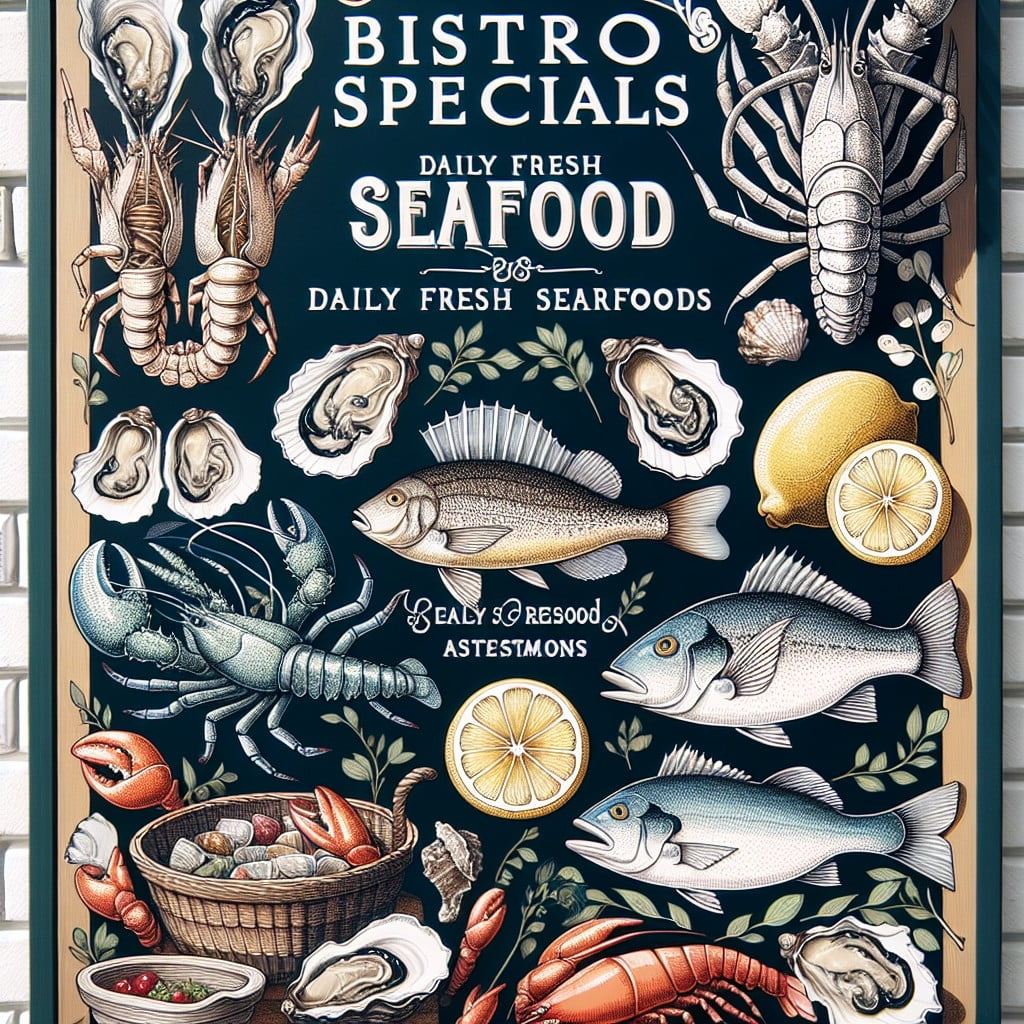
Your daily specials board is a great platform to highlight the freshest catch of the day, offering customers an opportunity to try something different and flavorful. Here are a few key strategies to optimize your board:
1. Immediate Sourcing: Highlight where you’re sourcing your seafood from to emphasize the freshness and support local fishermen or suppliers.
2. Preparation Styles: Describe different preparation methods for each seafood item. This could range from pan-fried, grilled, steamed, to poached, offering variety to your customers.
3. Catch Description: Provide brief details about the catch itself – its flavor, texture, and which beverages it pairs well with. This education can add value and stoke diners’ interest.
4. Rotating Choices: Keep the selection rotating with different types of seafood daily. This offers an element of surprise for repeat customers and keeps your menu exciting.
Remember, it’s all about effectively communicating to customers the unique selling points of your fresh seafood offerings.
Artistic Interpretation of Dishes
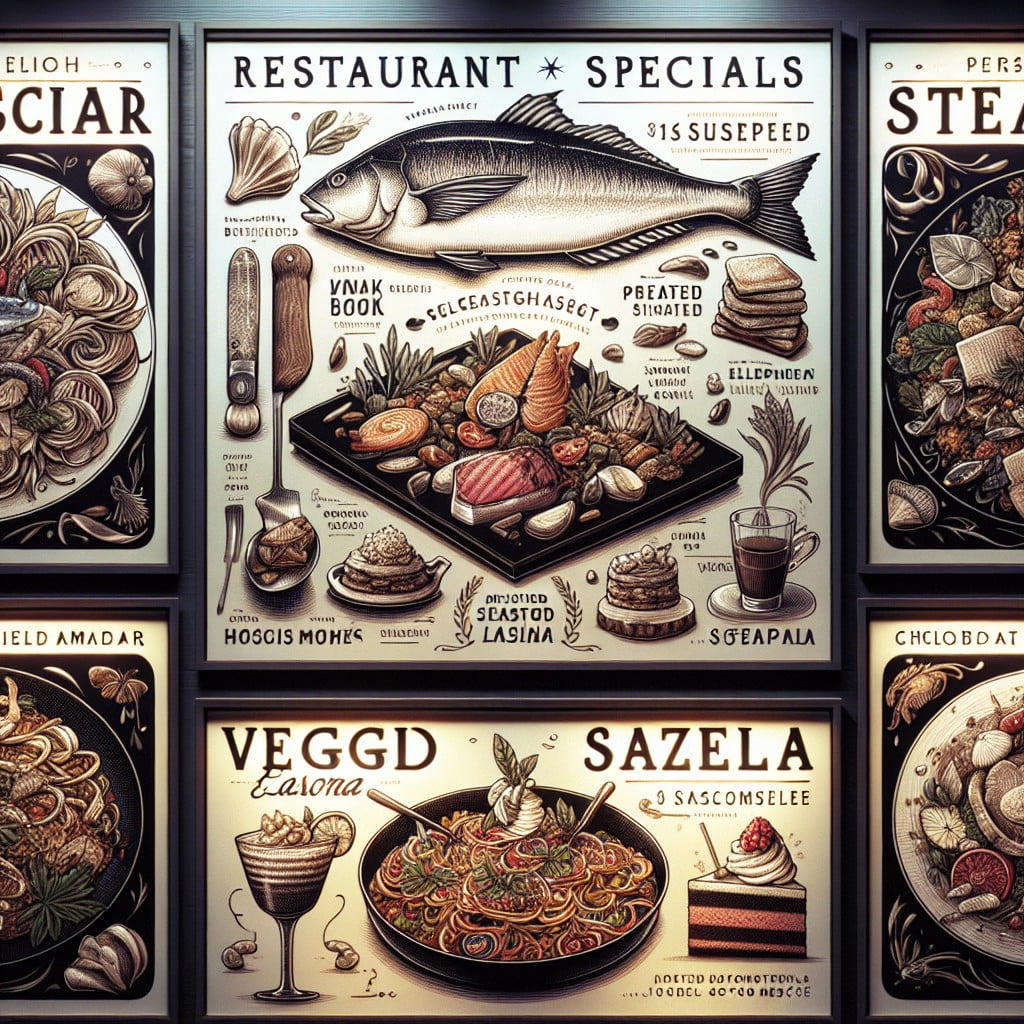
Creativity doesn’t just develop a buzz in the kitchen, it breathes life to your menu display too. By transposing the beauty of a dish onto the specials board, a visual feast welcomes the patrons even before they taste anything.
Start with simple sketches, play around with colors mirroring the vivid hues of your ingredients. A lobster thermidor, for instance, could be subtly represented with a vibrant orange and cream swirl.
Always remember, the aim isn’t photorealistic detail, but an abstract rendition that arrests attention and creates a sense of intrigue. Even minimalist line drawings can serve the purpose.
Collaborate with local artists for a genuine touch of originality. Their unique style can lend an appealing charm to your board, a charm that’s distinctively yours and not easily replicable.
Keep the board design fluid. Regular updates reflecting new dishes or changes in existing ones will keep your patrons eagerly anticipating the visual delights the board holds, always in tandem with the culinary ones.
Introducing Innovatively Named Dishes
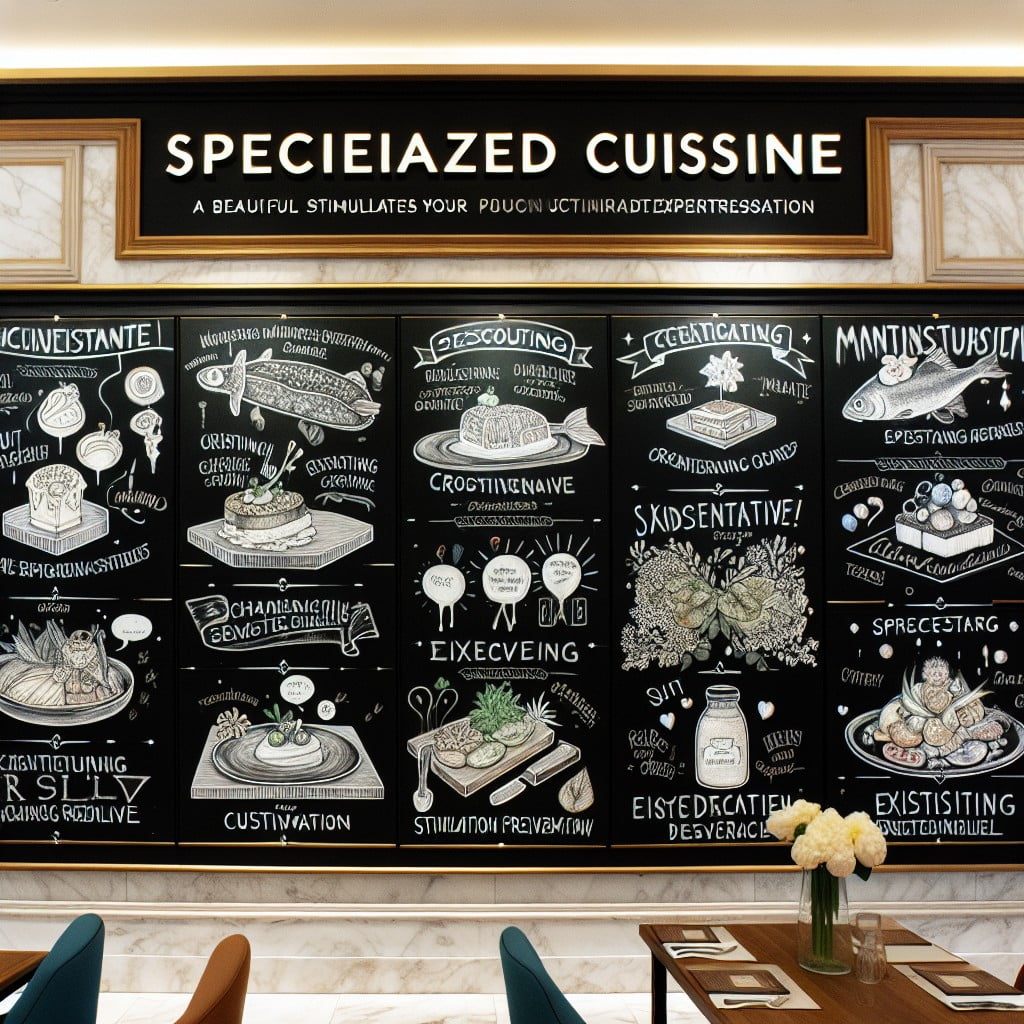
Innovation extends beyond the ingredients and presentation of restaurant offerings. A clever or unusual name for specials can generate buzz and renew interest in even the most classic dishes. Here are few points to consider:
- Use puns, alliterations, or rhymes: A taste of humor can make a dish more memorable, enticing customers to try and talk about it.
- Incorporate story into the names: People love narratives. Weave a tale into the name, perhaps about how the dish was invented or a tradition related to it.
- Use words that evoke imagery: Descriptive words can paint a virtual taste-test in your customers’ minds, making them eager to try the real thing.
- Make it topical or trendy: Creatively reflect current events, local happenings, or popular culture in the dish’s name, which can stimulate discussion and sharing on social media.
However, be sure that innovatively named dishes also deliver in taste and quality – nothing disappoints more than a catchy name followed by a lackluster meal.
Dessert-centric Menu Board
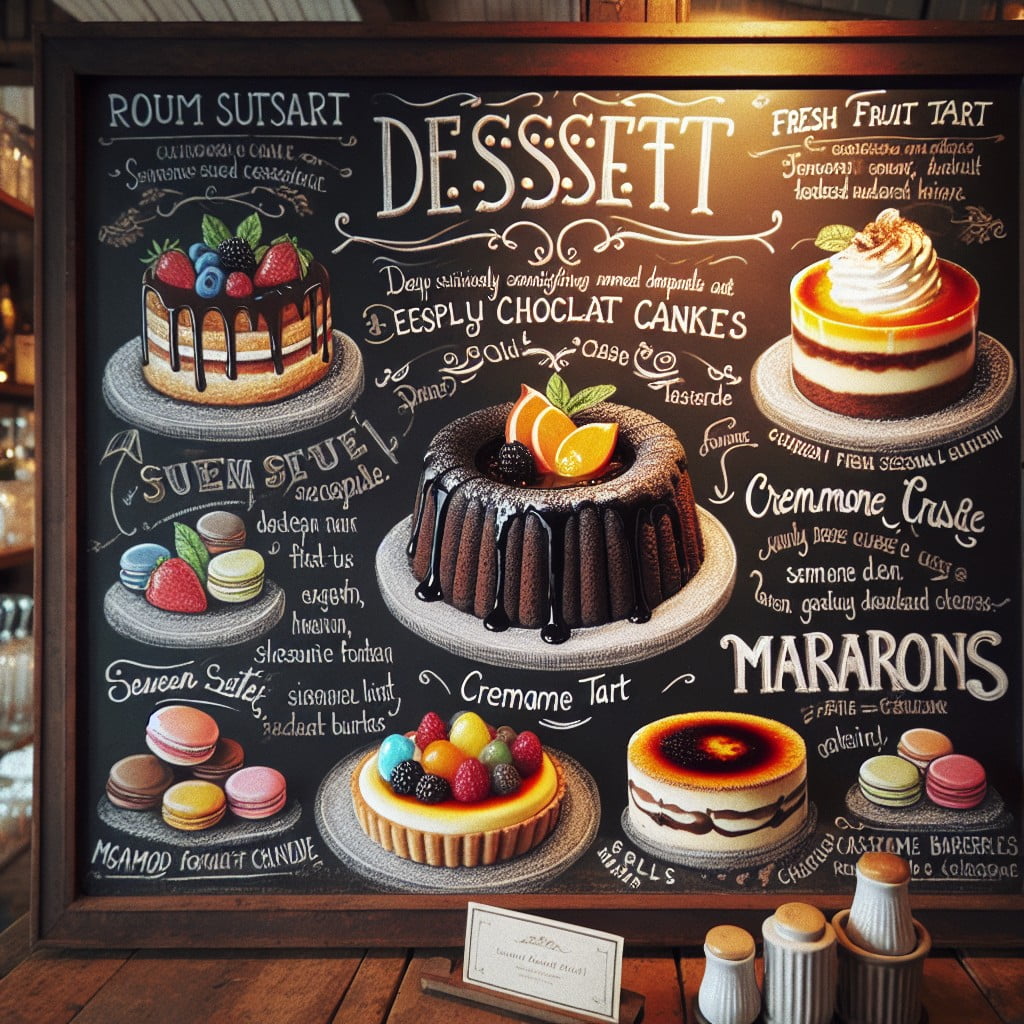
With a specific focus on sweet endings, this board is a delight for patrons who have a penchant for indulgence. Highlighting treats, from delicacies like French pastries to locally sourced fruit pies, can entice customers and help to boost post-meal sales.
Furthermore, illustrate the artistry involved in creating these garnished desserts to elevate their allure. Special mentions of gluten-free or dairy-free dishes can also cater to those with specific dietary requirements.
Pairings with dessert wines or recommendations for coffee blends that complement these delicacies could be another creative way to enhance the experience for the diner. Crafting the board with aesthetically pleasing designs and fonts can also mirror the elegance that’s expected of dessert presentation.
Displaying Seasonally Inspired Dishes
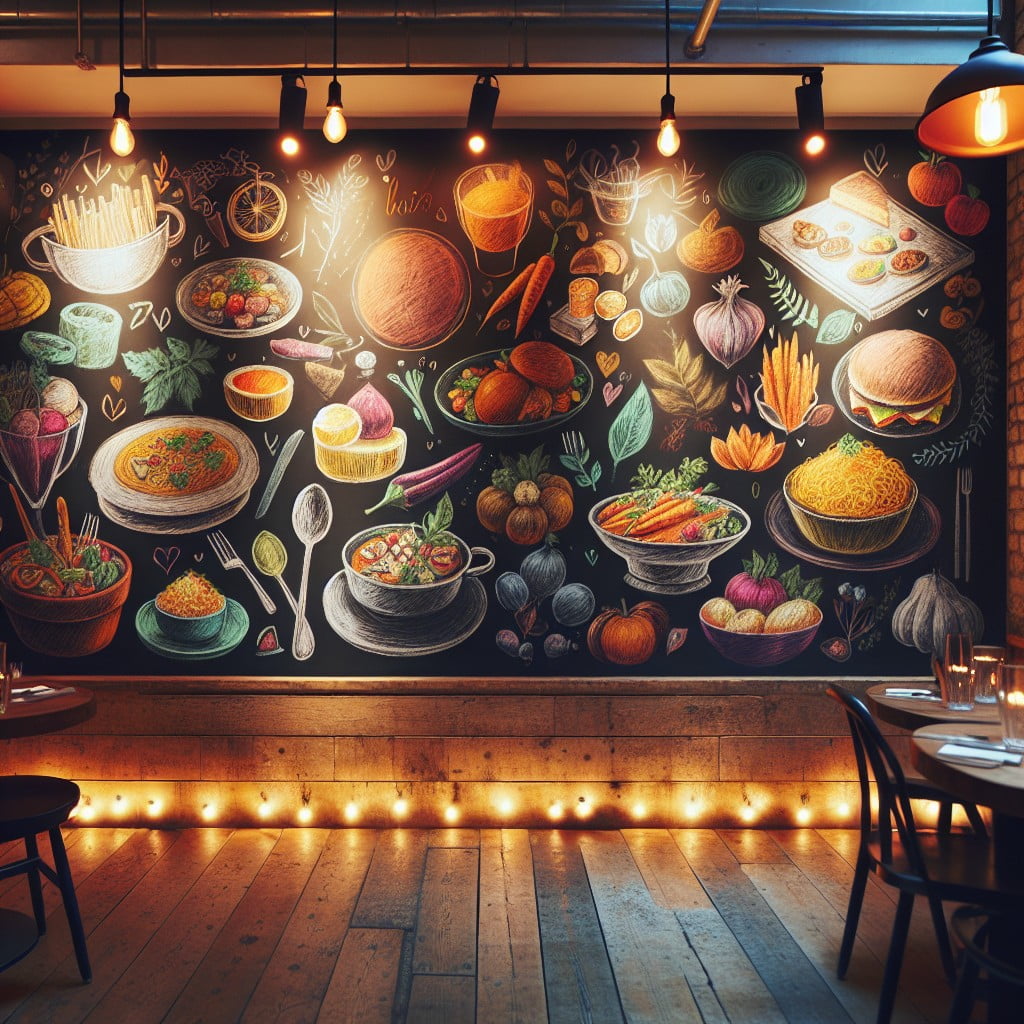
Capitalizing on the changing seasons can bring an element of suspense and excitement to your restaurant specials board. Here’s how:
1. Fresh Ingredients: It’s a known fact that fresh fruits and vegetables taste best when they’re in season. This offers an opportunity to showcase dishes highlighting these flavors. From spring’s colorful veggies to the earthy goodness of fall produce, seasonally inspired dishes can work wonders.
2. Farm-to-Table Appeal: Emphasis on regional, seasonal ingredients supports local farmers and adds an authentic touch to your restaurant’s dishes. It conveys a farm-to-table appeal that modern diners appreciate.
3. Creativity Aplenty: This approach encourages continual menu creativity, as the kitchen team can experiment with different produce every season.
4. Guest Anticipation: Offering dishes inspired by the seasons means your menu is ever-changing. This creates anticipation among regular guests who’ll be eager to see what’s new.
5. Cost-Effective: Purchasing in-season ingredients is often more economical, especially if sourcing locally, and in turn, can reduce your overall food costs.
While the concept of seasonal dishes might sound daunting, with some planning it can be an innovative, profitable, and environmentally-friendly strategy.
Culturally Themed Specials Board
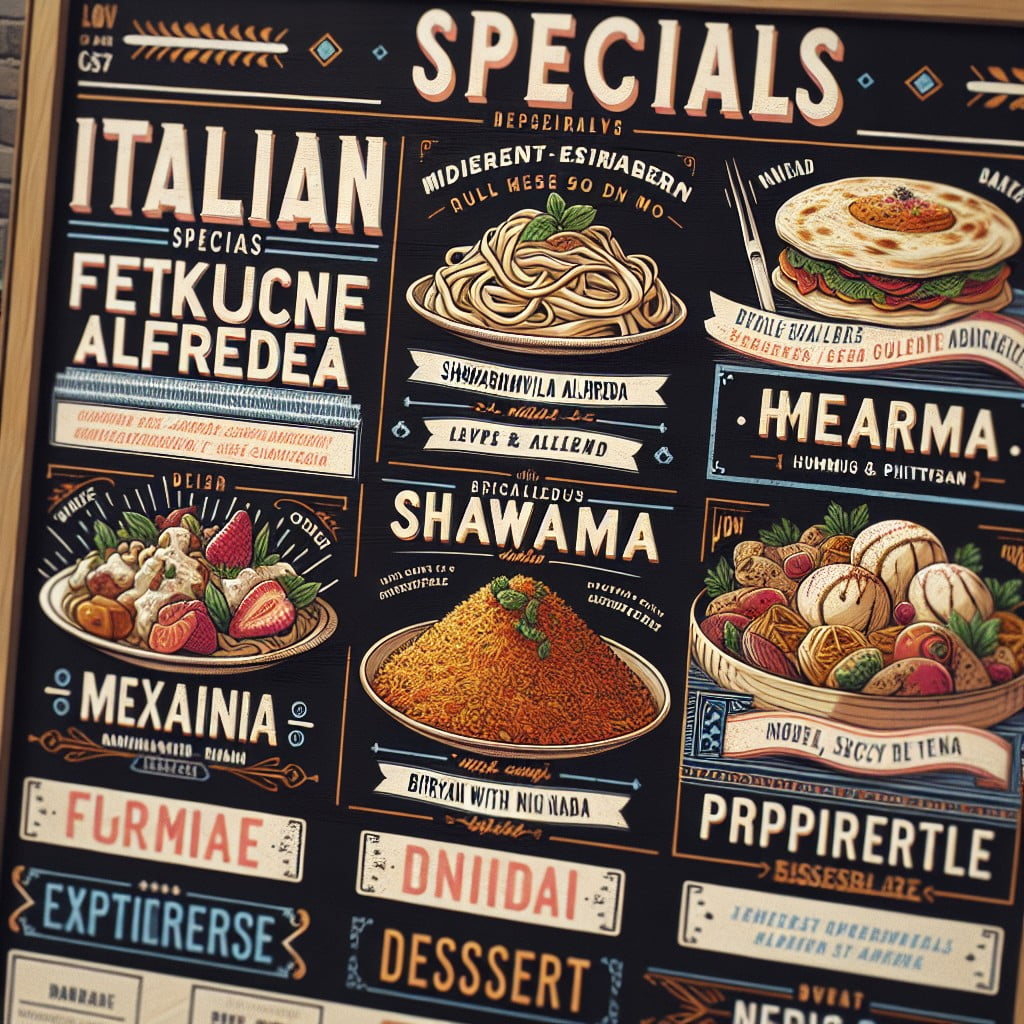
Embracing the diverse cultures our world offers, a themed specials board is a wonderful way to showcase globally inspired cuisines. By elevating dishes from various geographies or ethnicities, you encourage customers to embark on a culinary adventure.
For example, during the Chinese New Year, feature traditional Chinese dishes like dumplings or Peking duck. Or perhaps, one could celebrate the Mexican holiday “Cinco de Mayo” with specials on tacos and margaritas. You could also explore regional cuisines from your own country.
This strategy not only spices up your menu but also educates patrons about different areas of the world and their unique tastes. Plus, it can be a means to celebrate your customers’ various backgrounds, making your restaurant a more inclusive space.
Remember not to limit your cultural exploration to the food alone; align the entire restaurant experience with the chosen theme. This could involve music, décor, even the attire of the servers. But be mindful to approach it with respect and authenticity, to avoid cultural appropriation. Avoid stereotypes and do necessary research to represent the culture accurately.
In this way, your specials board transforms into a worldwide tour, providing diners with a unique and educational experience, right from their table.
Featuring Charity or Cause-Supporting Dishes
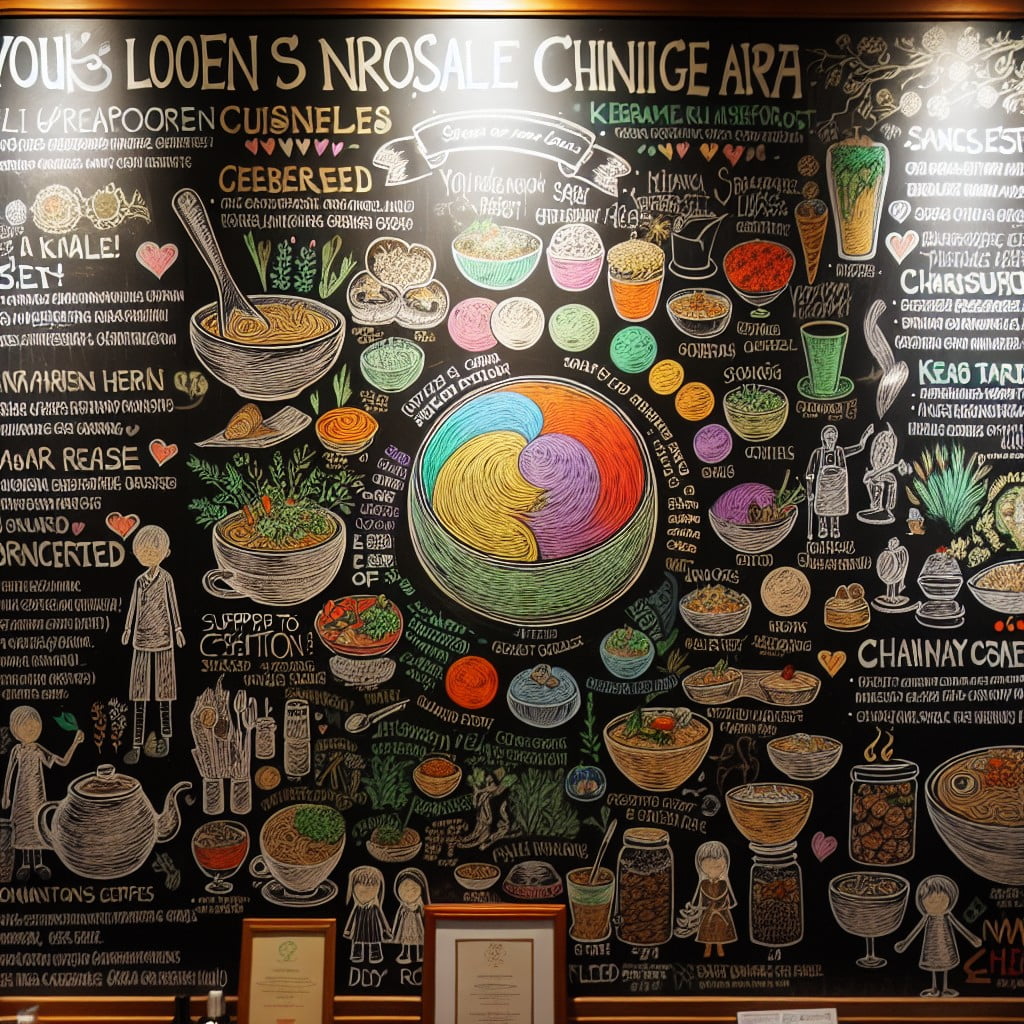
Incorporating charity-based menu items presents a dual opportunity. On one hand, it can attract patrons who share similar values. On the other hand, it offers establishments a chance to give back to the community.
Here’s how to implement:
- Collaborate with Local Non-profits: Connect with organizations within the community, to create a dish that reflects their mission.
- Percentage of Proceeds: Set up a system where a specific portion of the profit from a dish goes to a relevant charity or cause.
- Highlight the Cause: Dedicate a portion of the specials board to explaining the cause. This not only educates patrons but can spark important conversations too.
- Seasonal Causes: This could relate to help wildfire victims during fire season, supporting local food banks during holidays, or contributing to health causes on their awareness months.
Remember, transparency about the amount being donated and how the funds will be used can build lasting trust with patrons.
Ideas Elsewhere
- https://blog.photoadking.com/restaurant-special-board-ideas/
- https://www.shutterstock.com/search/restaurant-specials-board
- https://www.upshow.tv/resources/blog/10-cool-ways-to-utilize-your-restaurant-menu-display-boards
- https://www.aiscreen.io/blog/restaurant/best-menu-board-ideas/
- https://mindfuldesignconsulting.com/7-menu-design-ideas-for-small-dessert-shops-or-restaurants/
- https://bingage.com/blog/17-funny-creative-restaurants-chalkboard-signs/
Recap:
